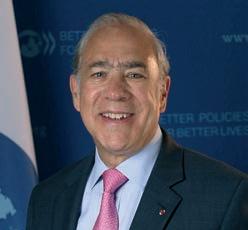DEVELOPMENT & GOVERNANCE
A guide for tackling fraud and corruption in EU investment funds Lisa Kilduff, OECD Directorate for Public Governance
https://bit.ly/372gqOU
just on business, as in Tomas’s case. Citizens lose out on new schools or improved health care services, and roads and buildings are left unfinished—powerful symbols of graft. Trust is being eroded, too: a recent poll shows that across the EU, only 34% of people have confidence in their national governments and parliaments. In some cases, citizens are even taking to the streets to protest fraud and corruption in EU funds.
©Alamy
So, what can governments do to tackle this issue? A recent OECD guide, Fraud and Corruption in European Structural and Investment Funds: A Spotlight on Common Schemes and Preventive Actions, provides evidence-based insights into the risks, and explains what responsible public officials can do to mitigate them.
Fraud and corruption are undermining the impact of the European Structural and Investment Funds, with recent high-profile cases resulting in mass protests and political upheaval. So what can EU governments do to tackle the problem? Tomas is a farmer who receives subsidies from the European Union. He has worked hard to cultivate an impressive 7,400 acres of land in a small village in an EU member state. It’s more than his livelihood—taking care of the farm and its livestock is a source of pride for Tomas, as it has been for generations. But for the last four years, Tomas has been embroiled in legal battles—and at times experienced threats and violence—over the rights to his land. Tomas’s troubles started in 2015, when an agricultural company began to cultivate arable land he owned. When he reported it to law enforcement authorities, the company presented what Tomas claims to be a falsified lease agreement and other forged documents to the national agency responsible for allocating EU grants to farmers. After being told that he must take his claim to court, Tomas was intimidated and physically attacked when he confronted the perpetrators. Nor did he get support from local political leaders; it turned out that they had allegedly helped the agricultural company carry out its scheme in exchange for kickbacks and bribes. Today, Tomas is still seeking justice for what happened to him. This is just one example of a fraudulent scheme that occurs in European Structural and Investment Funds (ESI). These funds aim to enhance the quality of life of EU citizens through a range of investments, including research and development, infrastructure, employment and agriculture. But how can we be sure that the money is reaching the intended recipients? Tomas’s case is not unique. Estimates from known cases of fraud and corruption suggest that over €390 million are misappropriated from the ESI funds each year. This is probably just the tip of the iceberg, as there is a lack of comprehensive data and a possibility that many cases may be going undetected. Yet these losses have tangible and lasting consequences, not
Take this example. In one EU member state, three public officials leaked sensitive information to a private company to help it win a contract for an EU-funded project. Later, these public officials modified project data to conceal their wrongdoing. Together with business representatives, they benefited from over €2 million in kickbacks. To prevent this fraudulent scheme from occurring in the first place, the authority in charge of selecting contractors should have used a secondary mechanism to review samples of winning bids, as well as rotating the staff who evaluate applications to reduce any risk of bias. As the project developed, the relevant authorities should have compared project outputs against costs to make sure the funds were being used properly. In another case, a beneficiary of EU funds was supposed to implement a motorway construction project. Instead, they colluded with contractors and organised crime groups to pocket the funds. To hide the fraudulent scheme, the beneficiary mimicked repair works on the motorway, for instance, by closing sections of the road without actually undertaking the construction or repairs. This could have been prevented by more rigorous background checks to identify any conflicts of interest between project partners. Simple regular on-site visits would have revealed that the works weren’t being carried out. There is much at stake when it comes to tackling fraud and corruption in ESI funds. In the past, governments have focused on compliance but now must do more to prevent fraud and corruption. By adopting a proactive risk management approach from the very start, they can confront these issues head-on and change them for good. Fostering integrity-driven policies across the EU can reduce the risk of fraud and allow societies to benefit fully from their rightful investment funds. And that means better lives for millions of people like Tomas, too. References OECD (2019), Tackling Fraud and Corruption Risks in the Slovak Republic: A Strategy with Key Actions for the European Structural and Investment Funds, OECD Public Governance Reviews, OECD Publishing, Paris, https://doi.org/10.1787/6b8da11a-en. OECD (2019), “Fraud and Corruption in European Structural and Investment Funds: A Spotlight on Common Schemes and Preventive Actions”, available at: https://www.oecd.org/gov/ethics/prevention-fraud-corruption-european-funds.pdf.
OECD Observer No 319-320 Q3-Q4 2019
27

















